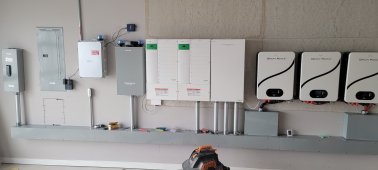Gubman
Not so New Member
- Joined
- Jul 25, 2022
- Messages
- 93
Hello all,
Currently running an Enphase roll out based on a mix of IQ8+s & IQ8Ms with 4 x 10T Encharge, a smart switch and 4C combiner. Needless to say, this can stay alive off-grid for about 2 days (48hrs) on average, given very minimal sun during consecutive days. I need more power to survive beyond 48 hours, but Enphase does not allow the addition of a 5th 10T without splitting the home into 2 separate branches, isolating the existing setup, requiring another combiner and smart switch. Enphase appears skittish to offer a coherent solution outside an Enphase hardware ecosystem - why? - reasons. Given the additional cost and inevitable system split, I have decided to attempt to incorporate a XW Pro & 48v rack batteries. Based on hours of reading & searching many forums, I see that this is possible, but have yet find anyone who has actually done it with Encharge batteries in the mix. I will call Schneider at some point, but wanted to load up with more detail prior to doing so. Anyone out there who has made the plunge? Is Schneider the way to go or is a more stable solution possible? I particularly perfer the low frequency inverter approach to complement the existing Encharge output. I am certified to install Enphase & aware of the frequency shifting incorporated to control production.
Currently running an Enphase roll out based on a mix of IQ8+s & IQ8Ms with 4 x 10T Encharge, a smart switch and 4C combiner. Needless to say, this can stay alive off-grid for about 2 days (48hrs) on average, given very minimal sun during consecutive days. I need more power to survive beyond 48 hours, but Enphase does not allow the addition of a 5th 10T without splitting the home into 2 separate branches, isolating the existing setup, requiring another combiner and smart switch. Enphase appears skittish to offer a coherent solution outside an Enphase hardware ecosystem - why? - reasons. Given the additional cost and inevitable system split, I have decided to attempt to incorporate a XW Pro & 48v rack batteries. Based on hours of reading & searching many forums, I see that this is possible, but have yet find anyone who has actually done it with Encharge batteries in the mix. I will call Schneider at some point, but wanted to load up with more detail prior to doing so. Anyone out there who has made the plunge? Is Schneider the way to go or is a more stable solution possible? I particularly perfer the low frequency inverter approach to complement the existing Encharge output. I am certified to install Enphase & aware of the frequency shifting incorporated to control production.
Last edited:




